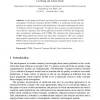Free Online Productivity Tools
i2Speak
i2Symbol
i2OCR
iTex2Img
iWeb2Print
iWeb2Shot
i2Type
iPdf2Split
iPdf2Merge
i2Bopomofo
i2Arabic
i2Style
i2Image
i2PDF
iLatex2Rtf
Sci2ools
ICCS
2007
Springer
2007
Springer
Data Assimilation in Multiscale Chemical Transport Models
In this paper we discuss variational data assimilation using the STEM atmospheric Chemical Transport Model. STEM is a multiscale model and can perform air quality simulations and predictions over spatial and temporal scales of different orders of magnitude. To improve the accuracy of model predictions we construct a dynamic data driven application system (DDDAS) by integrating data assimilation techniques with STEM. We illustrate the improvements in STEM field predictions before and after data assimilation. We also compare three popular optimization methods for data assimilation and conclude that LBFGS method is the best for our model because it requires fewer model runs to recover optimal initial conditions.
| Added | 08 Jun 2010 |
| Updated | 08 Jun 2010 |
| Type | Conference |
| Year | 2007 |
| Where | ICCS |
| Authors | Lin Zhang, Adrian Sandu |
Comments (0)

